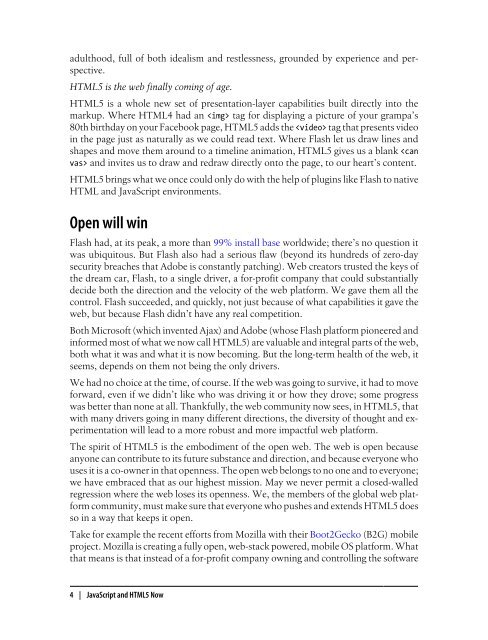JavaScript and HTML5 Now Kyle Simpson
JavaScript and HTML5 Now Kyle Simpson
JavaScript and HTML5 Now Kyle Simpson
You also want an ePaper? Increase the reach of your titles
YUMPU automatically turns print PDFs into web optimized ePapers that Google loves.
adulthood, full of both idealism <strong>and</strong> restlessness, grounded by experience <strong>and</strong> perspective.<br />
<strong>HTML5</strong> is the web finally coming of age.<br />
<strong>HTML5</strong> is a whole new set of presentation-layer capabilities built directly into the<br />
markup. Where HTML4 had an tag for displaying a picture of your grampa’s<br />
80th birthday on your Facebook page, <strong>HTML5</strong> adds the tag that presents video<br />
in the page just as naturally as we could read text. Where Flash let us draw lines <strong>and</strong><br />
shapes <strong>and</strong> move them around to a timeline animation, <strong>HTML5</strong> gives us a blank <strong>and</strong> invites us to draw <strong>and</strong> redraw directly onto the page, to our heart’s content.<br />
<strong>HTML5</strong> brings what we once could only do with the help of plugins like Flash to native<br />
HTML <strong>and</strong> <strong>JavaScript</strong> environments.<br />
Open will win<br />
Flash had, at its peak, a more than 99% install base worldwide; there’s no question it<br />
was ubiquitous. But Flash also had a serious flaw (beyond its hundreds of zero-day<br />
security breaches that Adobe is constantly patching). Web creators trusted the keys of<br />
the dream car, Flash, to a single driver, a for-profit company that could substantially<br />
decide both the direction <strong>and</strong> the velocity of the web platform. We gave them all the<br />
control. Flash succeeded, <strong>and</strong> quickly, not just because of what capabilities it gave the<br />
web, but because Flash didn’t have any real competition.<br />
Both Microsoft (which invented Ajax) <strong>and</strong> Adobe (whose Flash platform pioneered <strong>and</strong><br />
informed most of what we now call <strong>HTML5</strong>) are valuable <strong>and</strong> integral parts of the web,<br />
both what it was <strong>and</strong> what it is now becoming. But the long-term health of the web, it<br />
seems, depends on them not being the only drivers.<br />
We had no choice at the time, of course. If the web was going to survive, it had to move<br />
forward, even if we didn’t like who was driving it or how they drove; some progress<br />
was better than none at all. Thankfully, the web community now sees, in <strong>HTML5</strong>, that<br />
with many drivers going in many different directions, the diversity of thought <strong>and</strong> experimentation<br />
will lead to a more robust <strong>and</strong> more impactful web platform.<br />
The spirit of <strong>HTML5</strong> is the embodiment of the open web. The web is open because<br />
anyone can contribute to its future substance <strong>and</strong> direction, <strong>and</strong> because everyone who<br />
uses it is a co-owner in that openness. The open web belongs to no one <strong>and</strong> to everyone;<br />
we have embraced that as our highest mission. May we never permit a closed-walled<br />
regression where the web loses its openness. We, the members of the global web platform<br />
community, must make sure that everyone who pushes <strong>and</strong> extends <strong>HTML5</strong> does<br />
so in a way that keeps it open.<br />
Take for example the recent efforts from Mozilla with their Boot2Gecko (B2G) mobile<br />
project. Mozilla is creating a fully open, web-stack powered, mobile OS platform. What<br />
that means is that instead of a for-profit company owning <strong>and</strong> controlling the software<br />
4 | <strong>JavaScript</strong> <strong>and</strong> <strong>HTML5</strong> <strong>Now</strong>


